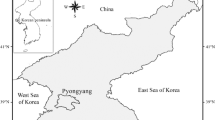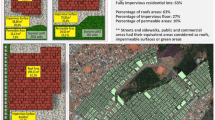Abstract
Purpose
The rapid urbanization and the constant expansion of urban areas during the last decades have locally led to increasing water shortage. Rainwater harvesting (RWH) systems have the potential to be an important contributor to urban water self-sufficiency. The goal of this study was to select an environmentally optimal RWH strategy in newly constructed residential buildings linked to rainwater demand for laundry under Mediterranean climatic conditions, without accounting for water from the mains.
Methods
Different strategies were environmentally assessed for the design and use of RWH infrastructures in residential apartment blocks in Mediterranean climates. The harvested rainwater was used for laundry in all strategies. These strategies accounted for (i) tank location (i.e., tank distributed over the roof and underground tank), (ii) building height considering the number of stories (i.e., 6, 9, 12, and 15), and (iii) distribution strategy (i.e., shared laundry, supply to the nearest apartments, and distribution throughout the building). The RWH systems consisted of the catchment, storage, and distribution stages, and the structural and hydraulic calculations were based on Mediterranean conditions. The quantification of the environmental performance of each strategy (e.g., CO2eq. emissions) was performed in accordance with the life cycle assessment methodology.
Results and discussion
According to the environmental assessment, the tank location and distribution strategy chosen were the most important variables in the optimization of RWH systems. Roof tank strategies present fewer impacts than their underground tank equivalents because they enhance energy and material savings, and their reinforcement requirements can be accounted for within the safety factors of the building structure without the tank. Among roof tanks and depending on the height, a distribution strategy that concentrates demand in a laundry room was the preferable option, resulting in reductions from 25 to 54 % in most of the selected impact categories compared to distribution throughout the building.
Conclusions
These results may set new urban planning standards for the design and construction of buildings from the perspective of sustainable water management. In this sense, a behavioral change regarding demand should be promoted in compact, dense urban settlements.




Similar content being viewed by others
References
Abdulla FA, Al-Shareef AW (2009) Roof rainwater harvesting systems for household water supply in Jordan. Desalination 243:195–207
AEMET. Spanish National Meteorological Agency (2013) Standard climate values. http://www.aemet.es/en/serviciosclimaticos/datosclimatologicos/valoresclimatologicosAccessed November 2013
Angrill S, Farreny R, Gasol CM, et al. (2012) Environmental analysis of rainwater harvesting infrastructures in diffuse and compact urban models of Mediterranean climate. Int J Life Cycle Assess 17:25–42
Bronchi V, Jolliet O (2002) Life cycle assessment of rainwater use for domestic needs. Inst Soil Water Manag 1–10
Commission Regulation (EU) No 1015/2010 of 10 November 2010 implementing Directive 2009/125/EC of the European Parliament and of the Council with regard to ecodesign requirements for household washing machines. Available at http://eur-lex.europa.eu/LexUri
Coombes PJ, Kuczera G, Kalma JD, Argue JR (2002) An evaluation of the benefits of source control measures at the regional scale. Urban Water 4:307–320
CYPE Ingenieros S.A. (2011) CYPE ingenieros, Software for architecture, engineering & construction. http://www.cype.es/.v.2011
Devkota J, Schlachter H, Apul D (2015a) Life cycle based evaluation of harvested rainwater use in toilets and for irrigation. J Clean Prod 95:311–321
Devkota JP, Burian SJ, Tavakol-Davani H, Apul DS (2015b) Introducing demand to supply ratio as a new metric for understanding life cycle greenhouse gas (GHG) emissions from rainwater harvesting systems. J Clean Prod. doi:10.1016/j.jclepro.2015.10.073
di Castri F, Mooney H (1973) Mediterranean type ecosystems—origin and structure. Springer
Domènech L, Saurí D (2011) A comparative appraisal of the use of rainwater harvesting in single and multi-family buildings of the metropolitan area of Barcelona (Spain): social experience, drinking water savings and economic costs. J Clean Prod 19:598–608
Elzen B, Geels F, Green K (2004) System innovation and the transition to sustainability: theory, evidence and policy. Edward Elgar Publishing, Inc, Northampton
EN 15804:2011 (2011) Sustainability of construction works—environmental product declarations—core rules for the product category of construction works. European Standard
Farreny R, Gabarrell X, Rieradevall J (2011a) Cost-efficiency of rainwater harvesting strategies in dense Mediterranean neighbourhoods. Resour Conserv Recycl 55:686–694
Farreny R, Morales-Pinzón T, Guisasola A, et al. (2011b) Roof selection for rainwater harvesting: quantity and quality assessments in Spain. Water Res 45:3245–3254
Fletcher TD, Deletic A, Mitchell VG, Hatt BE (2008) Reuse of urban runoff in Australia: a review of recent advances and remaining challenges. J Environ Qual 37:S116–S127
Frischknecht R, Jungbluth N, Althaus H-J, et al. (2005) The ecoinvent database: overview and methodological framework. Int J Life Cycle Assess 10:3–9
Ghisi E, Bressan DL, Martini M (2007) Rainwater tank capacity and potential for potable water savings by using rainwater in the residential sector of southeastern Brazil. Build Environ 42:1654–1666
Glendenning CJ, Vervoort RW (2011) Hydrological impacts of rainwater harvesting (RWH) in a case study catchment: the Arvari River, Rajasthan, India. Part 2. Catchment-scale impacts. Agric Water Manag 98:715–730
Grant T, Hallmann M (2003) Urban domestic water tanks : life cycle assessment. Water 22–27
Guinée JB, Gorrée M, Heijungs R, Huppes G, Kleijn R, Koning A de, Oers L van, Wegener Sleeswijk A, Suh S, Udo de Haes HA, Bruijn H de, Duin R van HM (2002) Handbook on life cycle assessment. Operational guide to the ISO standards. I: LCA in perspective. IIa: Guide. IIb: Operational annex. III: Scientific background. Kluwer Academic Publishers, ISBN 1–4020–0228-9, Dordrecht, 692 pp
Herrmann T, Schmida U (2000) Rainwater utilisation in Germany: efficiency, dimensioning, hydraulic and environmental aspects. Urban Water 1:307–316
Herz RK, Lipkow A (2002) Life cycle assessment of water mains and sewers. Water Sci Technol Water Supply 2:51–58
Hischier R, Weidema B, Althaus H, et al (2010) Implementation of life cycle impact assessment methods. Final report ecoinvent v2.2 No. 3.
ISO (2006) ISO 14040: 2006 Environmental management—life cycle assessment—principles and framework.
Jones MP, Hunt WF (2010) Performance of rainwater harvesting systems in the southeastern United States. Resour Conserv Recycl 54:623–629
Lassaux S, Renzoni R, Germain A (2007) Life cycle assessment of water: from the pumping station to the wastewater treatment plant. Int J 12:118–126
Leggett D, Brown R, Brewer D et al (2001) Rainwater and greywater use in buildings: best practice guidance. Construction Industry Research & Information Association (CIRIA), pp 134
Lemos D, Dias AC, Gabarrell X, Arroja L (2013) Environmental assessment of an urban water system. J Clean Prod 54:157–165
Lundie S, Peters GM, Beavis PC (2004) Life cycle assessment for sustainable metropolitan water systems planning. Environ Sci Technol 38:3465–3473
Lye DJ (2009) Rooftop runoff as a source of contamination: a review. Sci Total Environ 407:5429–5434
Meng L, Forberg A (2007) 3D building generalization. In: Mackaness W, Ruas A, Sarjakoski T (eds) Challenges in the portrayal of geographic information. Elsevier Science, Amsterdam, pp. 211–232
MetaBase ITeC (2010) Online ITeC database: prices, technical details, companies, certificates, product pictures and environmental data. http://www.itec.cat/metabase. Accessed February 2013
Morales-Pinzón T, Lurueña R, Rieradevall J, et al. (2012a) Financial feasibility and environmental analysis of potential rainwater harvesting systems: a case study in Spain. Resour Conserv Recycl 69:130–140
Morales-Pinzón T, Rieradevall J, Gasol C, Gabarrell X (2012b) Plugrisost® v1.0. Dynamic water flow model for domestic use, with emphasis on use of unconventional sources (rainwater, greywater)
Mwenge Kahinda J, Taigbenu AE (2011) Rainwater harvesting in South Africa: challenges and opportunities. Phys Chem Earth, Parts A/B/C 36:968–976
Ngigi SN (2003) What is the limit of up-scaling rainwater harvesting in a river basin? Phys Chem Earth 28:943–956
Nolde E (2007) Possibilities of rainwater utilisation in densely populated areas including precipitation runoffs from traffic surfaces. Desalination 215:1–11
Oliver-Solà J, Josa A, Arena AP, et al. (2011) The GWP-chart: an environmental tool for guiding urban planning processes. Application to concrete sidewalks. Cities. 28:245–250
Pandey DN, Gupta AK, Anderson DM (2003) Rainwater harvesting as an adaptation to climate change. Curr Sci 85:46–59
Petit-Boix A, Roigé N, de la Fuente A, et al. (2016) Integrated structural analysis and life cycle assessment of equivalent trench-pipe systems for sewerage. Water Resour Manag 30:1117–1130
Petit-Boix A, Sanjuan-Delmás D, Chenel S, et al. (2015) Assessing the energetic and environmental impacts of the operation and maintenance of Spanish sewer networks from a life-cycle perspective. Water Resour Manag 29:2581–2597
Petit-Boix A, Sanjuan-Delmás D, Gasol C, et al. (2014) Environmental assessment of sewer construction in small to medium sized cities using life cycle assessment. Water Resour Manag 28:979–997
PRé Consultants (2010) SimaPro 7.2.0. PRé Consultants, Amersfoort
Public Utilities Board of Singapore (PUB) (2012) Collecting every drop of rain. http://www.pub.gov.sg/LongTermWaterPlans/wfall.html. Accessed on 09/01/2012
Rahman A, Dbais J, Imteaz M (2010) Sustainability of rainwater harvesting systems in multistorey residential buildings. Am J Eng Appl Sci 3:73–82
Reitano R (2011) Water harvesting and water collection systems in Mediterranean area. The case of Malta. In: Procedia Engineering, pp 81–88
Riesenberger J, Koeller J (2005) Commercial laundry facilities. http://www.allianceforwaterefficiency.org/WorkArea/linkit.aspx?LinkIdentifier=id&ItemID=802
Roebuck R, Oltean-Dumbrava C, Tait S (2011) Whole life cost performance of domestic rainwater harvesting systems in the United Kingdom. Water Environ J 25:355–365
Saurí D (2003) Lights and shadows of urban water demand management: the case of the metropolitan region of Barcelona. Eur Plan Stud 11:229–243
Sazakli E, Alexopoulos A, Leotsinidis M (2007) Rainwater harvesting, quality assessment and utilization in Kefalonia Island, Greece. Water Res 41:2039–2047
Stokes J, Horvath A (2006) Life cycle energy assessment of alternative water supply systems. Int J Life Cycle Assess 11:335–343
van Roon M (2007) Water localisation and reclamation: steps towards low impact urban design and development. J Environ Manag 83:437–447
Vargas-Parra MV, Villalba G, Gabarrell X (2013) Applying exergy analysis to rainwater harvesting systems to assess resource. Resour Conserv Recycl 72:50–59
Venkatesh G, Hammervold J, Brattebø H (2009) Combined MFA-LCA for analysis of wastewater pipeline networks. J Ind Ecol 13:532–550
Villarreal EL, Dixon A (2005) Analysis of a rainwater collection system for domestic water supply in Ringdansen, Norrköping, Sweden. Build Environ 40:1174–1184
Ward S, Memon FA, Butler D (2010) Harvested rainwater quality: the importance of appropriate design. Water Sci Technol 61:1707–1714
Zhang Y, Chen D, Chen L, Ashbolt S (2009) Potential for rainwater use in high-rise buildings in Australian cities. J Environ Manag 91:222–226
Zhu K, Zhang L, Hart W, et al. (2004) Quality issues in harvested rainwater in arid and semi-arid loess plateau of northern China. J Arid Environ 57:487–505
Acknowledgments
The authors are grateful for the financial support of the Spanish Ministry of Science and Innovation of Spain (MICINN) within the project “Análisis ambiental del aprovechamiento de las aguas pluviales urbanas” (ref. CTM2010-17365). The authors also wish to thank the Catalan government for the scholarship enjoyed by S. Angrill and the Spanish Ministry of Education for the grant awarded to A. Petit-Boix (FPU13/01273).
Author information
Authors and Affiliations
Corresponding author
Additional information
Responsible editor: Holger Wallbaum
Electronic supplementary material
ESM 1
(DOCX 499 kb)
Rights and permissions
About this article
Cite this article
Angrill, S., Segura-Castillo, L., Petit-Boix, A. et al. Environmental performance of rainwater harvesting strategies in Mediterranean buildings. Int J Life Cycle Assess 22, 398–409 (2017). https://doi.org/10.1007/s11367-016-1174-x
Received:
Accepted:
Published:
Issue Date:
DOI: https://doi.org/10.1007/s11367-016-1174-x




